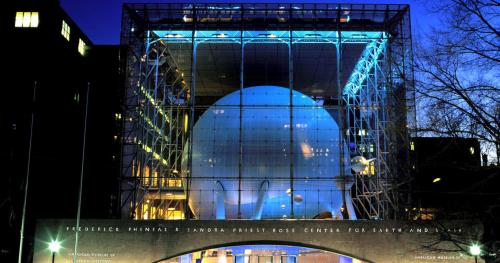 The iconic Hayden Planetarium Space Theater reopens today, with its newest Space Show, Worlds Beyond Earth,
The iconic Hayden Planetarium Space Theater reopens today, with its newest Space Show, Worlds Beyond Earth,
Narrated by Academy Award winner Lupita Nyong’o, the show about outer space features immersive visualizations, groundbreaking space missions, and breathtaking scenes depicting the evolution of our solar system. It’s all in state-of-the-art 8K on the most advanced planetarium projection system in the world.
Hayden Planetarium is part of the American Museum of Natural History, which re-opened in September with timed entry.
Worlds Beyond Earth premiered in January 2020, just weeks before AMNH closed its doors in March 2020. Th
The planetarium, part of the American Museum of Natural History, will be at limited capacity, as are NYC movie theaters, which re-opened earlier in March.
Because of physical distancing requirements, only up to 48 visitors will be welcomed to each showing in the Space Theater, which ordinarily seats up to 429.
There will be seven shows daily, and the theater will be cleaned between showtimes.
Reservations are essential. Reserve at www.amnh.org.
“We are thrilled to reopen the doors of the Hayden Planetarium Space Theater, a world-class facility with a long and storied history of bringing our visitors to the outer limits of space and the universe,” said Museum President Ellen V. Futter. “As New York City continues to extend its reopening and recovery, we are proud for this iconic theater to once again offer experiences that are transporting, enriching, and grounded in authentic science.”
“I’m an astrophysicist today because of a first encounter I had with the Hayden Planetarium when I was a child,” said Neil deGrasse Tyson, the Frederick P. Rose Director of the Hayden Planetarium. “And since then, the planetarium has continued to serve as the public’s conduit to the cosmos. Today – through the power of computing and the theater’s advanced digital projection system – visitors can experience what happens when we bring the universe down to Earth.”
About the Hayden Planetarium
First built in 1935 and named for philanthropist Charles Hayden, the Hayden Planetarium has played a seminal role in educating New Yorkers and visitors from around the world about the latest discoveries in space science.
Since the 1930s, the Hayden Planetarium has featured world-class astronomy programming and, with the opening of the Rose Center for Earth and Space in 2000, presented popular Space Shows that use advanced science visualization of authentic data to showcase the frontiers of astronomical research to the public.
The Hayden Planetarium Space Theater features state-of-the-art technology, including a custom Zeiss Mark IX star projector and Digital Dome Projection System, and draws on the Digital Universe, an atlas of the cosmos developed by the Hayden Planetarium in 1998, and the OpenSpace astrovisualization software to display a scientifically accurate view of the overservable universe based on millions of astronomical observations.
Worlds Beyond Earth, which is dedicated to the memory of Charles Hayden, opened in 2020, during the 150th anniversary of the year of his birth.
About the American Museum of Natural History (AMNH)
Founded in 1869 and currently celebrating its 150th anniversary, AMNH is one of the world’s preeminent scientific, educational, and cultural institutions. The Museum encompasses over 40 permanent exhibition halls, including those in the Rose Center for Earth and Space, as well as galleries for temporary exhibitions.
The museum’s approximately 200 scientists draw on a world-class research collection of more than 34 million artifacts and specimens, some of which are billions of years old, and on one of the largest natural history libraries in the world.
Through its Richard Gilder Graduate School, the Museum grants the Ph.D. degree in Comparative Biology and the Master of Arts in Teaching (MAT) degree, the only such free-standing, degree-granting programs at any museum in the United States.
The museum’s website, digital videos, and apps for mobile devices bring its collections, exhibitions, and educational programs to millions around the world.
Photo credits: ©AMNH Library

What do you think about this? We welcome your comments.